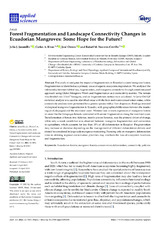Forest fragmentation and landscape connectivity changes in Ecuadorian mangroves: some hope for the future?
Autor
Jaramillo, Julio J.
Rivas, Carlos A.
Oteros, José
Navarro Cerrillo, Rafael M.
Editor
MDPIFecha
2023Materia
Ecuadorian forestsMangrove forests
Conservation
Deforestation
Connectivity patterns
METS:
Mostrar el registro METSPREMIS:
Mostrar el registro PREMISMetadatos
Mostrar el registro completo del ítemResumen
This study investigates the impact of fragmentation on Ecuador’s coastal mangrove forests. Fragmentation is identified as a primary cause of aquatic ecosystem degradation. We analyzed the relationship between habitat loss, fragmentation, and mangrove connectivity through a multitemporal approach using Global Mangrove Watch and fragmentation and connectivity metrics. The terrain was divided into 10 km2 hexagons, and six fragmentation metrics were calculated. A Getis–Ord Gi* statistical analysis was used to identified areas with the best and worst conservation status, while connectivity analyses were performed for a generic species with a 5 km dispersion. Findings revealed widespread mangrove fragmentation in Ecuador, with geographical differences between the insular region (Galapagos) and the mainland coast. Minimal loss or even expansion of mangrove forests in areas like the Galapagos Islands contrasted with severe fragmentation along the mainland coast. Transformation of forests into fisheries, mainly prawn factories, was the primary driver of change, while only a weak correlation was observed between mangrove fragmentation and conversion to agriculture, which accounts for less than 15% of all deforestation in Ecuador. Fragmentation may increase or decrease depending on the management of different deforestation drivers and should be considered in large-scale mangrove monitoring. Focusing only on mangrove deforestation rates in defining regional conservation priorities may overlook the loss of ecosystem functions and fragmentation.

